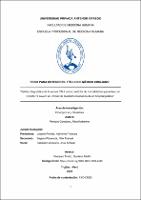Validez diagnóstica de la escala CALL como predictor de mortalidad en pacientes con COVID-19 severo en Unidad de Cuidados Intensivos de un hospital público

Ver/
Descargar
(application/pdf: 606.8Kb)
(application/pdf: 606.8Kb)
Fecha
2022Autor(es)
Pereyra Gonzáles, Alina Katherine
Metadatos
Mostrar el registro completo del ítemResumen
Establecer la validez diagnóstica de la escala CALL como
predictor de mortalidad en pacientes con COVID-19 severo en Unidad de
Cuidados Intensivos del Hospital Regional Docente de Trujillo desde abril
del 2020 hasta julio del 2021.
Material y métodos: Se llevó a cabo un estudio analítico, retrospectivo,
en el cual se incluyeron a 177 pacientes con COVID-19 severo internados
en Unidad de Cuidados Intensivos del Hospital Regional Docente de
Trujillo, según criterios de selección, se calculó la escala CALL para cada
uno y se asoció con la mortalidad encontrada; aplicándose la prueba
estadística chi cuadrado; posteriormente se realizó un análisis de regresión
multivariante para identificar los factores de riesgo asociados a la
mortalidad. A su vez se utilizó el AUROC (área bajo la curva ROC) para
establecer el rendimiento predictivo de la escala CALL.
Resultados: De una muestra de 177 pacientes, al analizar la información
mediante la curva ROC, se obtuvo un valor de corte 6 puntos para la
escala CALL, con un área bajo la curva (AUC) de 0.612 (p=0.014);
sensibilidad, especificidad, valor predictivo positivo y negativo de 86%,
29%, 60% y 62% respectivamente. No se encontraron diferencias
significativas estadísticamente en cuanto a sexo, edad, shock séptico,
SOFA, índice de comorbilidad de Charlson, necesidad de TRR ni
compliance estática. En cambio se evidenció asociación con la PaO2/FiO2.
Conclusión: En nuestra investigación la escala CALL es un predictor
válido de mortalidad con un valor de corte > 6 puntos, presentando una
sensibilidad del 86% (IC 95% 78-93), especificidad del 29% (IC 95% 19-
40), Valor predictivo positivo de 60% (IC 95% 52-69) y Valor predictivo
negativo de 62% (IC 95% 45-78); así también, encontramos el incremento
de la media de los valores para PaO2/FiO2 como factor protector frente a
la mortalidad. To establish the diagnostic validity of the CALL score as a
predictor of mortality in patients with severe COVID-19 in the Intensive Care
Unit of the Trujillo Regional Teaching Hospital from April 2020 to July 2021.
Material and methods: An analytical, retrospective study was carried out,
in which 177 patients with severe COVID-19 admitted to the Intensive Care
Unit of the Regional Teaching Hospital of Trujillo were included, according
to selection criteria, the CALL score was calculated for each one and was
associated with the mortality found; applying the statistical chi 2 test;
Subsequently, a multivariate regression analysis was performed to identify
risk factors associated with mortality. In turn, the AUROC (area under the
ROC curve) was used to establish the predictive performance.
Results: From a sample of 177 patients, when analyzing the information
using the ROC curve, a cut-off value of 6 points was obtained for the CALL
score, with an area under the curve (AUC) of 0.612 (p = 0.014); sensitivity,
specificity, positive and negative predictive value of 86%, 29%, 60% and
62% respectively. No statistically significant differences were found in terms
of sex, age, septic shock, SOFA, Charlson comorbidity index, need for renal
replacement therapy (RRT) or static compliance. On the other hand, an
association with PaO2 / FiO2 was evidenced.
Conclusion: In our investigation, the CALL scale is a valid predictor of
mortality with a cut-off value > 6 points, presenting a sensitivity of 86% (95%
CI 78-93), specificity of 29% (95% CI 19-40), Predictive value positive of
60% (95% CI 52-69) and negative predictive value of 62% (95% CI 45-78);
likewise, we found the increase in the mean of the values for PaO2/FiO2
as a protective factor against mortality.
Palabras clave
Colecciones
- Medicina Humana [2969]

